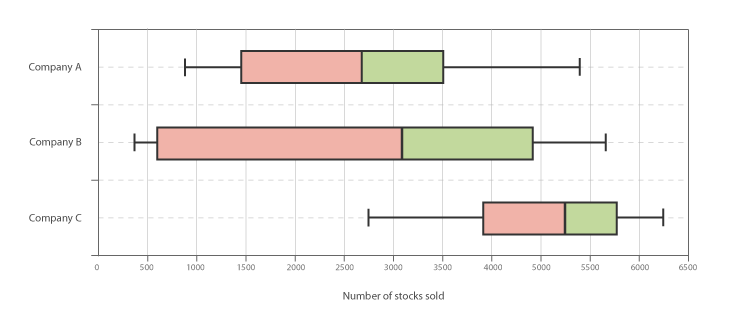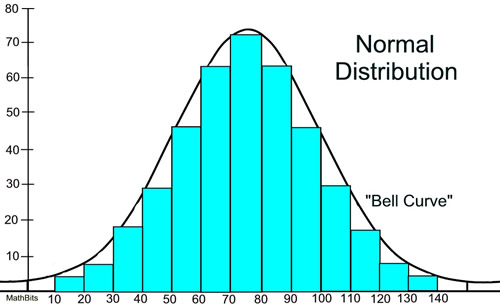FINAL EXAM STATISTICS VOCAB
5.0(11)
5.0(11)
Card Sorting
1/69
Earn XP
Description and Tags
Created in 2023 for M. Sumler's UMKC dual credit Elementary Statistics course.
Study Analytics
Name | Mastery | Learn | Test | Matching | Spaced | Call with Kai |
|---|
No study sessions yet.
70 Terms
1
New cards
Bar Graph
a graph made of bars whose heights represent the frequencies of respective categories (chapter 2)

2
New cards
Bernoulli Trial
one repetition of a binomial experiment (chapter 5)
3
New cards
Binomial Experiment
an experiment that contains *n* identical trials such that each of these *n* trials has only two possible outcomes; the probabilities of these two outcomes remain constant for each trial, and the trials are independent (chapter 5)
4
New cards
Binomial Probability Distribution
the probability distribution that gives the probability of *x* successes in *n* trials when the probability of success is *p* for each trial of a binomial experiment (chapter 5)
5
New cards
Box-And-Whisker Plot
a plot that shows the center, spread, and skewness of a data set with a box and two whiskers using the median, the first quartile, the third quartile, and the smallest and the largest values in the data set between the lower and the upper inner fences (chapter 3)

6
New cards
Census
a survey conducted by including every element of the population (chapter 1)
7
New cards
Central Limit Theorem
the theorem from which it is inferred that for a large sample size (*n* ≥ 30), the shape of the sampling distribution of *x̄* is approximately normal; also states that the shape of the sampling distribution of *p̂* is approximately normal for a sample if *np* > 5 and *nq* > 5 (chapter 7)
8
New cards
Chebyshev’s Theorem
for any number *k* greater than 1, at least (1 - 1/*k*^2) of the values for any distribution lie within *k* standard deviations of the mean (chapter 3)

9
New cards
Classical Probability Rule
the method of assigning probability to outcomes or events of an experiment with equally likely outcomes (chapter 4)
10
New cards
Combinations
the number of ways *x* elements can be selected from *n* elements; order of selection is **not** important (chapter 4)
11
New cards
Complementary Events
two events that taken together include all the outcomes for an experiment but do not contain any common outcome
EX: true and false, yes and no (chapter 4)
EX: true and false, yes and no (chapter 4)
12
New cards
Compound Event
an event that contains more than one outcome of an experiment (chapter 4)
13
New cards
Conditional Probability
the probability of an event subject to the condition that another event has already occurred (chapter 4)
14
New cards
Continuous Variable
a quantitative variable that can assume any numerical value over a certain interval or intervals (chapter 1)
15
New cards
Cumulative Frequency
the frequency of a class that includes all values in a data set that fall below the upper boundary or limit of that class (chapter 2)
16
New cards
Cumulative Frequency Distribution
a table that lists the total number of values that fall below the upper boundary or limit of each class (chapter 2)

17
New cards
Cumulative Relative Frequency
the cumulative frequency of a class divided by the total number of observations (chapter 2)
18
New cards
Dependent Events
two events for which the occurrence of one **does** change the probability of the occurrence of the other (chapter 4)
19
New cards
Descriptive Statistics
collection of methods for organizing, displaying, and describing, data using tables, graphs, and summary measures (chapter 1)
20
New cards
Discrete Variable
a quantitative variable whose values are countable (chapter 1)
21
New cards
Empirical Rule
for a specific bell-shaped distribution, about 68% of the observations fall in the interval (μ - σ) to (μ + σ), about 95% fall in the interval (μ - 2σ) to (μ + 2σ), and about 99.7% fall in the interval (μ - 3σ) to (μ + 3σ) (chapter 3)

22
New cards
Equally Likely Outcomes
two (or more) outcomes or events that have the same probability of occurrence (chapter 4)
23
New cards
Factorial
denoted by the symbol !; the product of all the integers from a given number to 1
EX: *n*! = the product of all integers from *n* to 1 (chapter 4)
EX: *n*! = the product of all integers from *n* to 1 (chapter 4)
24
New cards
Frequency Distribution
a table that lists all the categories or classes and the number of values that belong to each of these categories or classes (chapter 2)
25
New cards
Histogram
a graph in which classes are marked on the horizontal axis and frequencies, relative frequencies, or percentages are marked on the vertical axis represented by the heights of bars that are drawn adjacent to each other (chapter 2)

26
New cards
Hypergeometric Probability Distribution
the probability distribution that is applied to determine the probability of *x* successes in *n* trials when the trials are not independent (chapter 5)
27
New cards
Independent Events
two events for which the occurrence of one **does not** change the probability of the occurrence of the other (chapter 4)
28
New cards
Inferential Statistics
collection of methods that help make decisions about a population **based on sample results** (chapter 1)
29
New cards
Interquartile Range (IQR)
the difference between the third and the first quartiles (chapter 3)
30
New cards
Intersection of Events
given by the outcomes that are common to two (or more) events (chapter 4)
31
New cards
Joint Probability
the probability that two (or more) events occur together (chapter 4)
32
New cards
Law of Large Numbers
theory which states that if an experiment is repeated again and again, the probability of an event obtained from the relative frequency approaches the actual/theoretical probability (chapter 4)
33
New cards
Margin of Error
the quantity that is subtracted from and added to the value of a sample statistic to obtain a confidence interval for the corresponding population parameter (chapter 8)
34
New cards
Marginal Probability
the probability of one event or characteristic without consideration of any other event (chapter 4)
35
New cards
Mean
a measure of center calculated by dividing the sum of all values by the number of values in the data set; denoted by μ (chapter 3)
36
New cards
Mean of p̂
the mean of the sampling distribution of *p̂,* denoted by *μp̂* is equal to the population proportion *p* (chapter 7)
37
New cards
Mean of x̄
the mean of the sampling distribution of *x̄,* denoted by *μx̄,* is equal to the population mean *μ* (chapter 7)
38
New cards
Measures of Center
measures that describe the center of a distribution
EX: mean, median, and mode (chapter 3)
EX: mean, median, and mode (chapter 3)
39
New cards
Measures of Dispersion
measures that give the spread of a distribution
EX: range, variance, and standard deviation (chapter 3)
EX: range, variance, and standard deviation (chapter 3)
40
New cards
Measures of Position
measures that determine the position of a single value in relation to other values in a data set
EX: quartiles, percentiles, and percentile rank (chapter 3)
EX: quartiles, percentiles, and percentile rank (chapter 3)
41
New cards
Median
the value that divides a ranked data set into two equal parts (chapter 3)
42
New cards
Mode
the value (or values) that occurs with highest frequency in a data set (chapter 3)
43
New cards
Mutually Exclusive Events
two or more events that do not contain any common outcome and, hence, cannot occur together (chapter 4)
44
New cards
Normal Probability Distribution
the probability distribution of a continuous random variable that, when plotted, gives a specific bell-shaped curve; the parameters of the normal distribution are the mean *μ* and the standard deviation *σ* (chapter 6)

45
New cards
Outliers
values that are very small or very large relative to the majority of the values in a data set (chapter 2)
46
New cards
Pareto Chart
a bar graph in which bars are arranged in decreasing order of heights (chapter 2)

47
New cards
Percentile Rank
gives the percentage of values in the data set that are smaller than this value (chapter 3)
48
New cards
Permutations
number of arrangements of *x* items selected from *n* items; order of selections **is** important (chapter 4)
49
New cards
Poisson Probability Distribution
the probability distribution that gives the probability of *x* occurrences in an interval when the average number of occurrences in that interval is λ (chapter 5)

50
New cards
Population
the collection of all elements whose characteristics are being studied (chapter 1)
51
New cards
Probability
a numerical measure of the likelihood that a specific event will occur (chapter 4)
52
New cards
Qualitative Data
data generated by a qualitative variable – a variable that cannot assume numerical values but is classified into two or more categories (chapter 1)
53
New cards
Quantitative Data
data generated by a quantitative variable – a variable that can be measured numerically (chapter 1)
54
New cards
Quartiles
three summary measures that divide a ranked data set into four equal parts (chapter 3)
55
New cards
Random Sample
a sample drawn in such a way that each element of the population has some chance of being included in the sample (chapter 1)
56
New cards
Range
a measure of spread obtained by taking the difference between the largest and the smallest values in a data set (chapter 3)
57
New cards
Representative Sample
a sample that contains the characteristics of the populations as closely as possible (chapter 1)
58
New cards
Skewed-to-the-Left Histogram
a histogram with a longer tail on the left side (chapter 2)

59
New cards
Skewed-to-the-Right Histogram
a histogram with a longer tail on the right side (chapter 2)

60
New cards
Standard Deviation
a measure of spread that is given by the positive square root of the variance; denoted by *σ* (chapter 3)
61
New cards
Standard Deviation of p̂
the standard deviation of the sampling distribution of *p̂,* denoted by *σp̂*, is equal to (*√pq/n)* when *n/N* ≤ .05 (chapter 7)
62
New cards
Standard Deviation of x̄
the standard deviation of the sampling distribution of *x̄,* denoted by *σx̄,* is equal to *σ/(√n)* when *n/N* ≤ .05 (chapter 7)
63
New cards
Standard Normal Distribution
the normal distribution with *μ* = 0 and *σ* = 1; the units are denoted by *z* (chapter 6)

64
New cards
Stem-and-Leaf Display
a display of data in which each value is divided into two potions– a stem and a leaf (chapter 2)

65
New cards
Symmetric Histogram
a histogram that is identical on both sides of its central point (chapter 2)

66
New cards
Tree Diagram
a diagram in which each outcome of an experiment is represented by a branch of a tree (chapter 4)

67
New cards
Trimmed Mean
the *k*% trimmed mean is obtained by dropping *k*% of the smallest values and *k*% of the largest values from the given data and then calculating the mean of the remaining (100 - 2*k*)% of the values (chapter 3)

68
New cards
Union of Two Events
given by the outcomes that belong either to one or to both events (chapter 4)
69
New cards
Variance
a measure of spread; related to standard deviation (chapter 3)
70
New cards
Weighted Mean
mean of a data set whose values are assigned different weights before the mean is calculated (chapter 3)